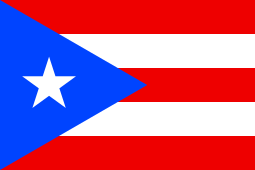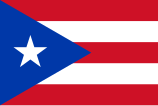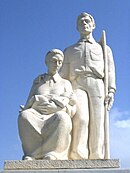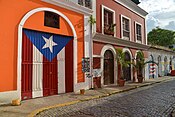
Back Vlag van Puerto Rico Afrikaans علم بورتوريكو Arabic علم بورتوريكو ARZ Puerto-Riko bayrağı Azerbaijani Сцяг Пуэрта-Рыка Byelorussian Zastava Portorika BS Bandera de Puerto Rico Catalan Portorická vlajka Czech Baner Puerto Rico Welsh Puerto Ricos flag Danish

| |
| |
| Use | Civil and state flag, civil and state ensign |
|---|---|
| Proportion | 2:3 |
| Adopted | August 3, 1995 by elected Puerto Rican government after issuing regulation identifying colors but not specifying color shades; medium blue replaced dark blue as de facto shade of triangle[1] |
| |
 | |
| Use | Civil and state flag, civil and state ensign |
| Proportion | 2:3 |
| Adopted | July 24, 1952 by elected Puerto Rican government with the establishment of the commonwealth after issuing law identifying colors but not specifying color shades; dark blue became de facto shade of triangle, replacing presumed original light blue[2][3] |
| |
 | |
| Use | Civil and state flag, civil and state ensign |
| Proportion | 2:3 |
| Adopted | December 22, 1895 by pro-independence members of the Revolutionary Committee of Puerto Rico exiled in New York City; members identified colors as red, white, and blue but did not specify color shades; some historians have presumed members adopted light blue shade based on the light blue flag of the Grito de Lares (Cry of Lares) revolt[4] |
| Design | Five equal horizontal stripes, alternating from red to white, with a blue equilateral triangle based on the hoist side bearing a large, white, upright five-pointed star in the center; see Specifications for dimensions and color schemes |
| Designed by | Disputed between Puerto Ricans Francisco Gonzalo Marín in 1895 and Antonio Vélez Alvarado in 1892; based on Cuban flag by Venezuelan Narciso López and Cuban Miguel Teurbe Tolón in 1849 |
| Part of a series on the |
| Culture of Puerto Rico |
|---|
 |
| Society |
| Topics |
| Symbols |
The flag of Puerto Rico (Spanish: Bandera de Puerto Rico) represents Puerto Rico and its people. It consists of five equal horizontal stripes, alternating from red to white, with a blue equilateral triangle based on the hoist side bearing a large, white, upright five-pointed star in the center. The white star stands for the island, the three sides of the triangle for the three branches of the government, the blue for the sky and the coastal waters, the red for the blood shed by warriors, and the white for liberty, victory, and peace.[5] The flag is popularly known as La Monoestrellada (The Monostarred), meaning having one star, a single star, or a lone star.[6][7] It is in the Stars and Stripes flag family.
In September 1868, the Revolutionary Committee of Puerto Rico launched the Grito de Lares (Cry of Lares) revolt against Spanish rule in the island, carrying as their standard a flag conceived by Ramón Emeterio Betances and embroidered by Mariana "Brazos de Oro" Bracetti.[8] Betances combined the quartered flag of the First Dominican Republic and the lone star on the flag of Cuba to create the flag, with the aim of promoting the union of neighboring Spanish-speaking Greater Antilles—the single-nation islands of Cuba and Puerto Rico, and the Dominican Republic in the two-nation island of Hispaniola—into a regional Antillean Confederation for the protection and preservation of their sovereignty and interests.[9] Marking the establishment of a national Puerto Rican consciousness under colonial rule for the first time, the Bandera del Grito de Lares (Cry of Lares flag), most commonly known as the Bandera de Lares (Lares flag), is recognized as the first flag of Puerto Rico.[10]
In December 1895, exiled Puerto Rican revolutionaries, many of them veterans of the Grito de Lares (Cry of Lares) revolt, re-established the Revolutionary Committee of Puerto Rico under the name Sección Puerto Rico del Partido Revolucionario Cubano (Puerto Rico Section of the Cuban Revolutionary Party) as part of the Cuban Revolutionary Party in New York City, where they continued to advocate for Puerto Rican independence from Spain with the support of Cuban national hero José Martí and other Cuban exiles, who similarly began their struggle for self-determination in 1868 when the Grito de Yara (Cry of Yara) revolt triggered the Ten Years' War (Guerra de los Diez Años) for independence against Spanish rule in Cuba, which, along with Puerto Rico, represented all that remained from Spain’s once extensive American empire since 1825.
Determined to affirm the union of the Cuban and Puerto Rican struggle for national independence and fight against Spanish colonialism and imperialism into a single, common cause, the committee, with the knowledge and approval of their fellow Cuban exiles, unanimously adopted the Cuban flag with colors inverted as the new flag to represent an independent Republic of Puerto Rico, replacing the Lares flag, which had been used by revolutionaries as the flag of a prospective independent Puerto Rico since their attempt at self-determination in 1868, but was eventually rejected, as it represented a failed revolt, a sentiment strongly supported by Lola Rodríguez de Tío, Puerto Rican poet, pro-independence leader, and committee member, who spent her later life exiled in liberated Cuba.[11][12]
Members of the Puerto Rican revolutionary committee identified the colors of their new flag as "red", "white", and "blue" but failed to specify any color shades.[13] Relying on contemporaneous but secondary oral sources, some historians have presumed that light blue was the color shade specifically adopted by the committee members, as their sources claim this was the same shade used on the Lares flag, the first revolutionary flag many of said members had rallied around in 1868.[4] However, like with the flag of 1895, which appears in one of its oldest color depictions in the early 1900s with a medium blue shade, there is no written primary source account specifying the original color shade of blue used on the Lares flag, the only two surviving original renditions of which feature different color shades of blue: one uses light blue and the other dark blue.[14][15][16]
The new revolutionary flag of Puerto Rico was first flown on the island in May 1896 during the funeral of pro-independence Puerto Rican leader and Grito de Lares veteran José Gualberto Padilla, and in March 1897 during the Intentona de Yauco (Attempted Coup of Yauco), the second and final revolt against Spanish rule prior to the invasion, occupation, and annexation of the island by the U.S. during the Spanish-American War in 1898.[17] As with the Lares flag, the use and display of this second flag was outlawed, as the only flags permitted to be flown in colonial Puerto Rico were the Spanish flag (1493 to 1898) and the American flag (1898 to 1952).
In July 1952, after several failed attempts by the colonial elected government of Puerto Rico in 1916, 1922, 1927, and 1932 to formalize the flag of 1895 as the flag of Puerto Rico, the government finally adopted it as the island’s official standard with the establishment of the Commonwealth of Puerto Rico (Spanish: Estado Libre Asociado de Puerto Rico, lit. 'Free Associated State of Puerto Rico'), identifying its colors by law as "red", "white", and "blue" but not specifying any official color shades.[2][11] Luis Muñoz Marín, the architect and first governor of the commonwealth, and his administration, did not use a light or medium blue color shade for the triangle of the flag, but a dark blue one, which some have said was deliberately done to distance the flag from its revolutionary origins and link it to the similarly striped American flag through a shared shade of dark blue with the aim of conveying a message of harmony between Puerto Rico and the U.S.[18]
In August 1995, the government of Puerto Rico issued a regulation regarding the use of the flag titled "Reglamento sobre el Uso en Puerto Rico de la Bandera del Estado Libre Asociado de Puerto Rico" ("Regulation on the Use in Puerto Rico of the Flag of the Commonwealth of Puerto Rico"), in which the government once again identified the colors to be used as "red", "white", and "blue" but did not specify any official color shades.[1] To this day, the color shades of the flag of Puerto Rico have never been officially determined by law in Puerto Rico, making all shades of blue legally legitimate and acceptable.
Therefore, it is common to see the triangle of the flag of Puerto Rico with different color shades of blue, ranging from the lighter sky blues to the medium azure blues and darker navy blues. Usually, but not always, the shade of blue displayed on the flag is used to show preference on the issue of Puerto Rico’s political status, with light blue, the shade presumably used by pro-independence revolutionaries in 1868 and 1895, representing independence from the U.S., dark blue, the shade used by pro-American functionaries since 1952, representing statehood or integration into the U.S. as a state, and medium blue, the shade in-between pro-independence light blue and pro-statehood dark blue most commonly used by the government and people since the 1990s, representing the current intermediary status of commonwealth as an unincorporated and organized U.S. territory.
Puerto Rico's flag ranked seventh out of 72 entries in a poll regarding flags of subdivisions of Canada and the United States conducted by the North American Vexillological Association in 2001.[19]
- ^ a b "Reglamento de Puerto Rico 1995". www.lexjuris.com. Retrieved 2023-10-27.
- ^ a b "Ley del 24 de julio de 1952" (PDF). Archived from the original (PDF) on 2012-02-19.
- ^ Cite error: The named reference
reglamento2was invoked but never defined (see the help page). - ^ a b "¿Cuál es el azul correcto de la bandera puertorriqueña?". Primera Hora (in Spanish). December 23, 2014. Retrieved March 7, 2023.
- ^ "Puerto Rico". flagspot.net. Retrieved 12 June 2015.
- ^ ASALE (2023-10-13). "monoestrellada | Diccionario de americanismos". «Diccionario de americanismos» (in Spanish). Retrieved 2023-10-22.
- ^ "La Monoestrellada ya ondea en la plaza de las banderas de los Juegos Panamericanos". Primera Hora (in Spanish). October 18, 2023. Retrieved January 19, 2024.
- ^ "Historical Flags of Puerto Rico". welcome.topuertorico.org. Retrieved 2023-10-25.
- ^ "La Habana Elegante - Invitation au voyage". www.habanaelegante.com. Retrieved 2023-10-25.
- ^ "Puerto Rico - Cinco Siglos de Historia"; by: Francisco Sacrano; publisher: McGraw Hill Interamericana, SA, 1993; pag. 533
- ^ a b "Historia de Nuestra Bandera". Ateneo Puertorriqueño. September 16, 2014. Retrieved 24 November 2023.
- ^ "El origen y los colores de nuestra bandera". eladoquintimes.com. Retrieved 2023-11-26.
- ^ "Sobre las banderas de Cuba y Puerto Rico". editorialakelarre.blogspot.com. Retrieved 2023-10-28.
- ^ "Porto Rico United States Possesion, Postcard (1900-1920)". La Biblioteca Digital Puertorriqueña del Sistema de Bibliotecas del Recinto de Río Piedras de la Universidad de Puerto Rico (in Spanish). July 14, 2006. Retrieved November 27, 2023.
- ^ "Exhiben en UPR bandera de Lares con 150 años". Primera Hora (in Spanish). September 16, 2018. Retrieved March 7, 2023.
- ^ "Muestran antigua bandera del Grito de Lares que se exhibe en museo de España". El Nuevo Día (in Spanish). April 22, 2022. Retrieved November 23, 2023.
- ^ "Reproducciones, 1896, El entierro de José Gualberto Padilla". thomasjimmyrosariofloresblog.wordpress.com. Retrieved 2023-11-26.
- ^ Flags of the World; Commonwealth of Puerto Rico, Estado Libre Asociado de Puerto Rico, Flags of the World, Retrieved Feb. 25, 2009
- ^ Kaye, Edward B. (June 10, 2001). "2001 State/Provincial Flag Survey" (PDF). Retrieved February 3, 2024.

